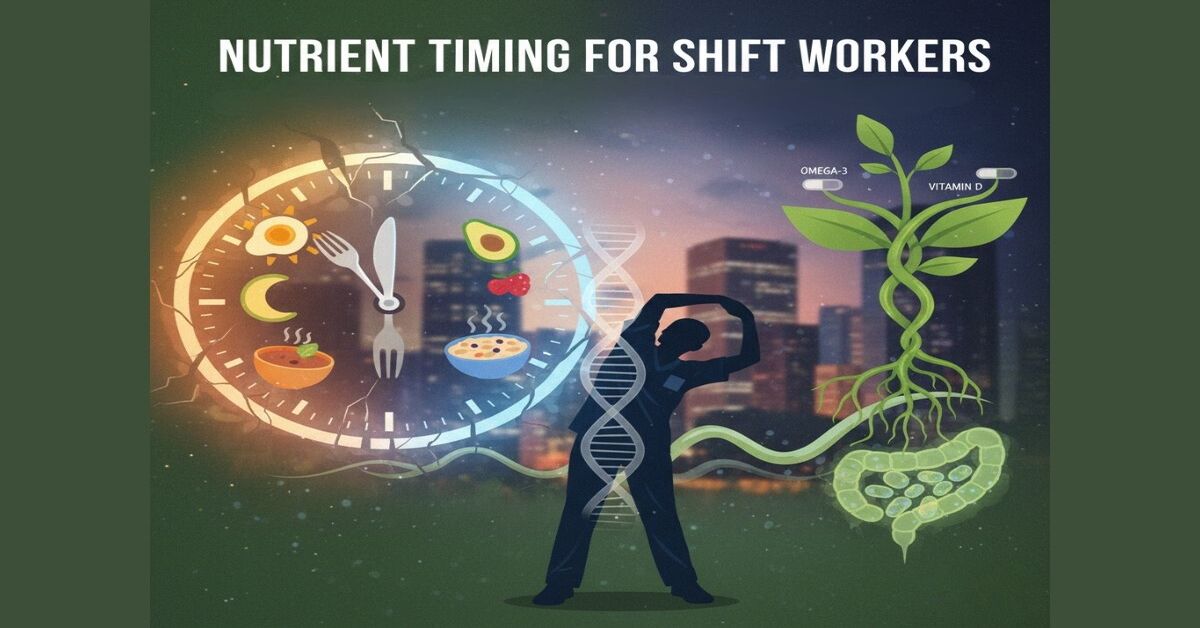Introduction
Shift work is now a cornerstone of the modern economy — from healthcare to logistics, millions of Americans work outside the traditional 9-to-5 schedule. Yet, behind the productivity lies a growing health crisis: circadian disruption. When the body’s internal clock clashes with work hours, metabolism, hormones, digestion, and even mental health suffer.
But here’s the good news: nutrient timing can restore balance naturally. By aligning food intake with your body’s biological rhythms — even if you work nights — you can stabilize blood sugar, improve energy, enhance recovery, and protect long-term health.
This guide dives into how nutrient timing can help shift workers beat fatigue, inflammation, and hormonal chaos, and reclaim control over their metabolism in 2025 and beyond.

Understanding Circadian Disruption in Shift Work
Your body runs on a 24-hour internal clock known as the circadian rhythm. This rhythm regulates sleep, hunger, hormone release, and metabolism. However, night shifts or rotating shifts confuse the system — the brain perceives darkness as “time to rest,” while your schedule demands alertness.
Key physiological effects of circadian disruption include:
| Effect | Impact on Health |
|---|---|
| Insulin resistance | Higher risk of weight gain and type 2 diabetes |
| Cortisol imbalance | Increased stress and poor recovery |
| Melatonin suppression | Impaired sleep quality |
| Leptin & ghrelin disruption | Increased hunger and cravings |
| Reduced thermogenesis | Slower metabolism |
Why Nutrient Timing Matters for Shift Workers
Most nutrition advice assumes daytime activity — but shift workers need a completely different rhythm. When meals are timed poorly (like eating large meals at 3 AM), the body struggles to process nutrients efficiently. Insulin sensitivity plummets at night, meaning calories are more likely stored as fat.
A nutrient timing strategy focuses not just on what you eat but when you eat — aligning meals with periods when your body is best equipped to digest and utilize nutrients.
Key benefits of optimized nutrient timing:
- Improved blood sugar regulation
- Enhanced muscle recovery and energy levels
- Better sleep quality post-shift
- Reduced gastrointestinal distress
- Protection from chronic metabolic disease
The Core Principles of Nutrient Timing for Shift Workers
Let’s break down how to apply this scientifically:
1. Align Meals with Wake Cycles, Not Clock Time
Eat your first meal within 60–90 minutes of waking — regardless of whether it’s 7 AM or 7 PM. Your body’s internal clock resets partly through food intake. This helps reestablish metabolic rhythm.
Pro Tip: Avoid eating large meals before bed. Keep your “nighttime” period fasted or light to allow melatonin-driven recovery.
2. Prioritize Protein Early in the Wake Phase
Protein helps suppress hunger hormones and supports lean muscle retention. A high-protein first meal (25–35g) improves alertness and balances energy for the next several hours.
Example:
- 3 eggs, Greek yogurt, and berries
- Protein smoothie with whey, oats, and almond butter
3. Limit Carbohydrates During the Night Shift
At night, your body’s ability to metabolize carbs declines. Save the bulk of your carbohydrates for the “daytime” hours (the first half of your waking period).
During night shifts:
- Focus on protein + fiber + healthy fats
- Keep carbs below 30g in any single meal during dark hours
4. Hydration and Electrolyte Control
Dehydration and electrolyte imbalance can mimic fatigue. However, over-hydration can cause bathroom interruptions and stress the kidneys.
Optimal guideline:
- Sip water throughout the shift (not chug)
- Add electrolyte tablets mid-shift if sweating or fatigued
- Reduce fluid intake 1 hour before bed to improve sleep
5. Use a Controlled Fasting Window
A 12-hour eating window (e.g., 6 PM–6 AM) can work well for night workers. Fasting during the “biological night” — even when awake — helps restore metabolic flexibility and reduce inflammation.
Example Schedule for a Night Shift Worker:
| Time | Meal | Key Focus |
|---|---|---|
| 6:30 PM | Protein + complex carbs | Pre-work energy |
| 10:00 PM | Protein + veggies | Mid-shift stability |
| 2:00 AM | Light snack (protein bar or nuts) | Prevent energy dips |
| 7:00 AM | Small balanced meal | Post-shift recovery |
| 8:00 AM–6:00 PM | Fasting & sleep | Circadian alignment |
6. Smart Supplementation for Circadian Support
Shift workers can benefit from certain nutrients that help restore balance:
| Supplement | Function | Timing |
|---|---|---|
| Magnesium glycinate | Promotes sleep & relaxes muscles | Before bed |
| Vitamin D3 | Compensates for lack of sunlight | With first meal |
| Melatonin (0.5–1mg) | Aids circadian reset | 1 hour before sleep |
| Ashwagandha | Reduces cortisol & anxiety | Mid-shift or before bed |
| Omega-3s | Reduces inflammation | With main meal |
7. Light Exposure and Meal Synergy
Food timing alone isn’t enough — your light exposure needs alignment too.
Try to mimic natural daylight during your working hours and reduce blue light exposure before sleep. Pair your first meal with bright light to signal “morning” to your brain.
Pro Tip:
Invest in a portable light therapy lamp if you work nights. This amplifies the positive effect of nutrient timing on your circadian rhythm.
Expert Insights
“Meal timing is one of the few modifiable lifestyle factors that can resynchronize disrupted circadian rhythms,” says Dr. Satchin Panda, author of The Circadian Code.
“Even small shifts — like restricting food intake to 12 hours or aligning eating with daylight — can dramatically improve metabolic health in shift workers.”
Actionable Checklist: Nutrient Timing for Shift Workers
✅ Eat within 60–90 minutes of waking
✅ Prioritize protein in your first meal
✅ Limit carbs during dark hours
✅ Hydrate strategically (no over-drinking)
✅ Use a consistent 12-hour eating window
✅ Add magnesium, D3, and omega-3 support
✅ Expose yourself to bright light during wake hours
✅ Keep sleep area dark, quiet, and cool
FAQs
Q1: Should I drink coffee during night shifts?
Yes, but only in the first half of your shift. Caffeine too close to sleep delays melatonin release and worsens circadian misalignment.
Q2: What’s the best meal before bed after a night shift?
Choose a light protein-based meal like Greek yogurt or cottage cheese with fruit. Avoid heavy carbs or fried foods.
Q3: How long does it take to adjust to a new eating schedule?
Most people notice improvements within 7–10 days, as their metabolism adapts to new timing cues.
Q4: Can intermittent fasting work for shift workers?
Yes, but the fasting window must match your sleep cycle — not the clock. Fasting while sleeping is key.
Authoritative Resources
- National Sleep Foundation – Shift Work & Sleep
- Harvard Health – The Circadian Rhythm and Metabolism Connection
- CDC – Workplace Health for Shift Workers
Other Interesting Articles
You may also like reading:
- Electrolyte Burnout: Why Over-Hydration Can Hurt Performance
- Hidden Hunger: Why Nutrient Deficiency Can Stall Weight Loss Even with Clean Eating
Conclusion
Nutrient timing is more than a dietary hack — it’s a circadian repair system for modern workers. By syncing meals, supplements, and light exposure with your biological rhythm, you can overcome fatigue, enhance metabolism, and preserve long-term health.
In 2025, the shift work epidemic doesn’t have to mean poor health.
It’s time to fuel smarter, not harder — and let your biology work with you, not against you.

